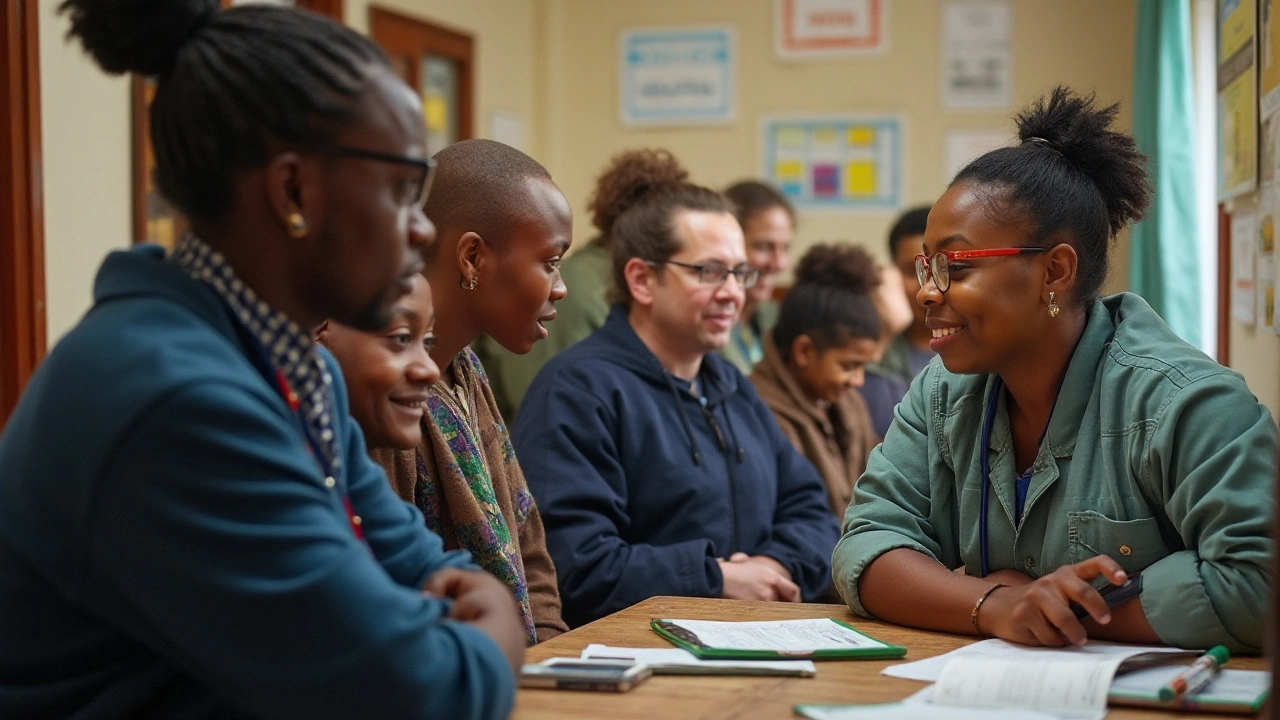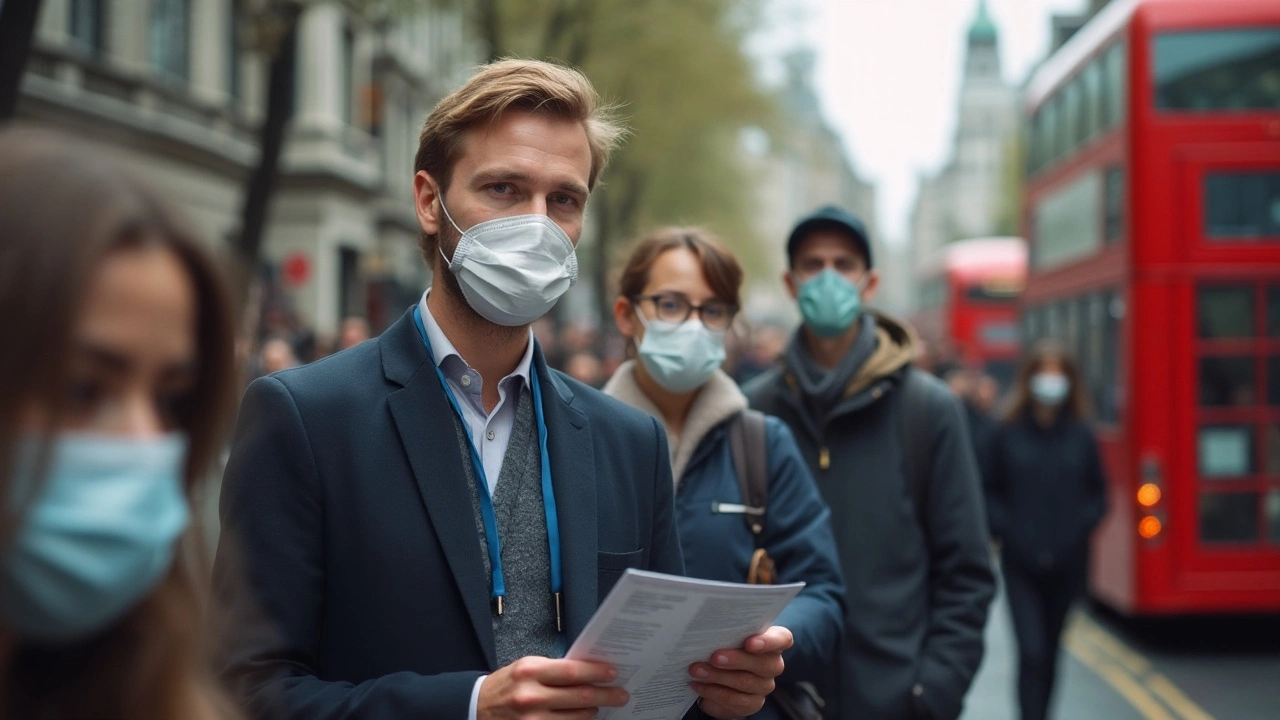Pulmonary tuberculosis (TB) is more than just a historical footnote; it's a living battle for millions across the globe today. This airborne infection, caused by the bacterium Mycobacterium tuberculosis, primarily targets the lungs but can affect other parts of the body as well. Despite being treatable, tuberculosis remains one of the top infectious disease killers worldwide.
The worldwide burden of tuberculosis is staggering, with millions of new cases diagnosed each year. This disease's grip is especially tight in regions with limited access to healthcare, where it thrives in the shadows of poverty and malnutrition. Efforts to combat TB are often thwarted by drug resistance, inadequate healthcare infrastructure, and social stigma.
Yet, there is hope. Innovation in treatment, renewed focus on prevention, and a better understanding of the disease's spread are paving the way for more effective control measures. As we delve deeper into the facts of TB, it's important to raise awareness and support ongoing efforts to make the world a safer place for everyone.
- Understanding Pulmonary Tuberculosis
- Global Impact and Statistics
- Challenges in Prevention and Treatment
- Future Prospects in TB Control
Understanding Pulmonary Tuberculosis
Pulmonary tuberculosis is a complex disease with a rich history that intertwines with the evolution of medical science. At the heart of TB lies the bacterium Mycobacterium tuberculosis. This pathogen was discovered by Robert Koch in 1882, marking a milestone in the fight against infectious diseases. It's fascinating how such tiny organisms have far-reaching impacts because this bacterium primarily infects the lungs by spreading through airborne droplets when an infected person coughs, sneezes, or even talks. The persistence of TB is attributed to its ability to remain dormant in the body, reactivating once the immune system is compromised. Cases like these challenge doctors even today, begging the question of how nature and medicine continue to work in concert and conflict.
Not just a modern concern, TB has been a scourge for centuries, often known as 'the white plague' due to its severe symptoms and widespread nature. The disease is characterized by prolonged coughing, chest pain, and hemoptysis, which is coughing up blood, alongside systemic signs like fever and night sweats. The complexity of its symptoms means TB can often mimic other lung diseases, leading to diagnostic challenges. Interestingly, before the advent of effective antibiotics, sanatoriums were designed for rest and long-term care of TB patients, depicting both a cultural and medical response to this relentless disease. If you're curious about the treatment framework, envision a balanced regiment of rest, nutrition, and specialized medication that attacks the bacteria from varied angles.
Pulmonary tuberculosis does not discriminate, yet its impact is felt hardest in areas where healthcare infrastructure lags. It’s within these underserved populations that diagnosis and treatment become a grueling battle. Early detection is key, which involves a combination of skin tests, blood tests, and chest X-rays to identify active infections. Moreover, TB bacteria have a notorious ability to develop resistance to drugs, complicating treatment plans and extending recovery times. According to the World Health Organization, MDR-TB, or multi-drug-resistant tuberculosis, presents a considerable challenge, affecting hundreds of thousands globally. It requires the use of more expensive, more toxic, and less effective drugs over longer periods. The stark reality of these medicines, however, underpins the beauty of modern pharmacy, dedicated teams continuously fine-tuning innovations to lead to a world free of TB.
"In our fight against tuberculosis, it is imperative not only to envision a disease-free world but also to empower communities with the tools and knowledge to combat it effectively." - Dr. Maria Van Kerkhove, World Health Organization.
Prevention plays a pivotal role in managing tuberculosis. Simple measures, such as improving living conditions, minimizing crowding, enhancing ventilation, and educating about good respiratory hygiene, go a long way in limiting the spread of TB. Vaccines like BCG (Bacille Calmette-Guérin) are another layer of protection, primarily given to infants in countries with high TB prevalence. But the journey is far from over. Innovations like new drug regimens and continued research into a more effective vaccine give us formidable tools in our arsenal against TB. It is through these methods we not only manage but also hope to eradicate this ancient scourge.

Global Impact and Statistics
Tuberculosis remains a colossal threat across the globe, impacting both individual lives and entire economies. The disease, long regarded as a relic of the past, shocks us with its persistent prevalence today. Over ten million people develop tuberculosis annually, and the shadow of death looms for over a million of them. Its omnipresence in low-income countries is particularly alarming, where the socio-economic fabric is already fragile. Though modern medicine offers remedies, these fail to reach numerous individuals who require them most. The economic implications are profound, given that TB affects many during their most productive years, leading to a decline in workforces across many nations.
The World Health Organization consistently emphasizes the urgent need for global action against TB. Many countries strive diligently to meet the WHO's dream of a TB-free world but face mountains of challenges. Emerging drug-resistant strains of Mycobacterium tuberculosis pose even more significant challenges in these regions, adding complexity to the treatment landscape. The access and availability of suitable medical infrastructure remain sticking points, with many suffering in silence. It is not just about the numbers of people who fall ill, but the cascading effect it has globally. "Without proper intervention, TB will continue to hunt silently," warned the 2020 WHO report
highlighting the critical state of affairs.
Understanding where the disease is most rampant helps in orchestrating tailored interventions. Asia and Africa have the lion's share, with India alone accounting for a quarter of the cases. Communicable as it is, urban slums become hotbeds for its spread. The close-knit communities unwittingly become conduits for the bacteria, spreading it with ease. Investing in public health infrastructure and education can halt this spread. Prevention, they say, is better than cure, and awareness drives play a formidable role in this aspect. Such campaigns are instrumental in reducing stigma and encouraging individuals to seek timely medical attention.
Advancements in diagnostics offer glimmers of hope. Rapid testing procedures help in detecting the disease early, allowing for faster intervention. Governments recognize the economic burden TB places on their healthcare systems, leading to substantial investments in research and development. International collaborations and data sharing have improved strategic approaches, aiding in the war against the disease. Global efforts have seen a gradual decline in TB mortality rates, inching closer to the target of ending the epidemic by 2030.
Pulmonary tuberculosis, though a giant, faces formidable foes across the globe. Everyone has a role to play, from those on the front lines of healthcare to the individuals practicing caution in their day-to-day lives. With a united front, the impact of TB need not be as daunting, paving the path to a healthier and safer world for future generations.

Challenges in Prevention and Treatment
Addressing pulmonary tuberculosis brings unique challenges in both its prevention and treatment, largely due to its complex nature and the multifaceted global environment it operates within. One of the most significant hurdles in managing TB is the persistence of multidrug-resistant strains. These strains develop when the bacteria survive inadequate or incomplete treatment, often due to limited drug supply or patient's inability to adhere to the lengthy treatment regimen. This resistance complicates the battle against TB, as it requires alternative and often more toxic drugs, which can be prohibitively expensive for those affected.
Moreover, the stigma associated with tuberculosis itself impedes prevention efforts substantially. In many parts of the world, individuals fear ostracism and discrimination should their condition become public knowledge. This fear can lead to delays in seeking medical attention, allowing the disease to progress unchecked and increasing the likelihood of transmission. TB is often referred to as a 'disease of poverty', as crowded living conditions, undernutrition, and limited access to healthcare create fertile grounds for its spread. It presents a vicious cycle in which the disease exacerbates poverty, and poverty in turn fuels its transmission.
Access to effective healthcare is another major barrier. In resource-limited settings, there is often a severe shortage of trained healthcare professionals and diagnostic facilities. Rapid and accurate diagnosis is critical for both effective treatment and reducing transmission rates. Unfortunately, the technologies and infrastructure needed for such diagnostics are limited in many high-burden countries.
Dr. Mario Raviglione, former head of the WHO's Global TB Program, once remarked, "For every undiagnosed case, there are countless more who are exposed and at risk of infection. Robust health systems are our frontline defense."
Preventive measures, while conceptually straightforward, require consistent implementation and widespread community engagement. Vaccination, though available in the form of the Bacillus Calmette–Guérin (BCG) vaccine, offers only partial protection and is less effective in adults. Efforts to develop a more effective vaccine continue, but progress is incremental. Education plays a critical role in prevention as well. Increasing public awareness about hygiene practices, symptom recognition, and the importance of completing treatment can significantly aid in reducing TB incidence rates.
Equitable access to medications and treatments is imperative to overcoming these challenges. Initiatives like the Global Fund to Fight AIDS, Tuberculosis and Malaria, and GAVI, the vaccine alliance, are vital partners in these regions. They strive to distribute resources and knowledge where they are most needed, but they face their own hurdles in maintaining funding and logistical support. The concerted effort of governments, international organizations, and local communities is essential to making significant strides in TB prevention and treatment, ultimately breaking the cycle that this disease perpetuates on a global scale.

Future Prospects in TB Control
As we peer into the future of pulmonary tuberculosis control, the glimmers of hope illuminating the path forward are many. Innovative approaches in treatment and prevention are emerging as promising strategies to curb this relentless disease. Foremost among these is the development of new vaccine candidates that present a potential game-changer in TB prevention. Current efforts focus on enhancing the BCG vaccine, which has been in use for over a century but is only partially effective in adults. Scientific breakthroughs in genetic research are paving the way for more targeted vaccines that offer better protection to diverse populations worldwide.
In addition to vaccines, advancements in diagnostic technologies are set to revolutionize TB control efforts. Rapid diagnostic tools, capable of identifying drug-resistant strains more efficiently, are in development. This is especially crucial in tackling the growing menace of multidrug-resistant tuberculosis (MDR-TB), which complicates treatment regimens and significantly impacts patient outcomes. Coupled with improved diagnostic capabilities, digital health innovations, such as electronic adherence monitoring and virtual care platforms, can enhance treatment adherence, particularly in resource-limited settings.
A critical element of future TB control also hinges on addressing underlying social determinants. Reducing poverty, improving nutrition, and enhancing living conditions are paramount. Programs focused on integrating TB control within broader healthcare systems and community-based interventions show significant promise. Engaging local communities in TB control efforts can empower individuals and lead to more sustainable outcomes.
Global impact initiatives spearheaded by organizations such as the World Health Organization (WHO) continue to play a pivotal role. “Ending the TB epidemic by 2030 is an achievable target,” asserts Dr. Tedros Adhanom Ghebreyesus, Director-General of WHO, emphasizing the necessity of global solidarity and commitment.
“It requires a paradigm shift in thinking and doing,” Dr. Tedros added, underlining the importance of innovative approaches beyond traditional public health strategies.
Furthermore, financial investments in TB research must not be overlooked. Despite being a leading cause of death, tuberculosis research receives only a fraction of the funding allocated for other diseases. An increase in resources dedicated to TB research will be essential to drive the breakthroughs needed in the fight against this disease. Partnerships between governments, private sectors, and non-profits can mobilize the needed support.
Ultimately, the future prospects in TB control rest on a multifaceted approach that integrates scientific innovation with social and economic interventions. With concerted efforts, collaborative action, and sustained momentum, the vision of a TB-free world may well transform from a distant hope to a realized achievement, changing countless lives in the process.



15 Comments
Tyler Heafner January 22, 2025 AT 16:07
Addressing pulmonary tuberculosis requires coordinated public‑health strategies, robust diagnostic networks, and unwavering political commitment. Strengthening community outreach programs ensures that at‑risk populations receive timely screening and education. Moreover, integrating TB services with broader primary‑care systems reduces stigma and improves treatment adherence. Investment in affordable drug regimens and patient support mechanisms is essential to curb transmission. The collective effort of governments, NGOs, and local health workers will ultimately drive down the global burden.
anshu vijaywergiya January 23, 2025 AT 06:00
From the bustling streets of Kolkata to the quiet towns of the Midwest, the shadow of TB looms large, reminding us that no corner of the world is truly insulated from its reach. The narrative of this ancient scourge is not merely a medical tale but a human saga of resilience, tragedy, and hope. When we shine a light on the socioeconomic currents that feed the disease, we begin to untangle the complex web that sustains it. Advocacy, vaccination drives, and relentless research form the triumvirate that can finally tilt the scales. Let us not forget the countless faces behind the statistics-each a story yearning for a cure.
ADam Hargrave January 23, 2025 AT 19:54
Oh sure, because a 10‑minute cough is the perfect excuse to ignore a worldwide epidemic.
Michael Daun January 24, 2025 AT 09:47
TB ain’t just some old story its real today and we gotta step up our game.
Rohit Poroli January 24, 2025 AT 23:40
The emergence of multidrug‑resistant (MDR) strains underscores the necessity for Directly Observed Therapy, Short‑course (DOTS) adherence, and pharmacokinetic optimization. Molecular diagnostics like GeneXpert have accelerated identification of rifampicin resistance, enabling timely regimen adjustments. However, health‑system bottlenecks often delay drug procurement, compromising therapeutic outcomes. Strengthening supply chains and training laboratory personnel are pivotal to bridge this gap. Ultimately, a synergistic approach combining biomedical innovation with socioeconomic interventions will curtail the MDR‑TB tide.
William Goodwin January 25, 2025 AT 13:34
When you think about it, TB is more than a bacterium-it’s a cultural narrative that spans continents 🌍. From ancient sanatoria to modern mobile clinics, humanity’s response has evolved, yet the core challenge remains: reaching the most vulnerable. Vaccination campaigns like BCG are a starting point, but they’re just the first brushstroke on a larger mural of public‑health art 🎨. Embracing digital adherence tools can turn the tide, giving patients a voice and a reminder in their pockets. Let’s keep pushing the envelope, because every breakthrough, no matter how small, lights up a path out of the darkness.
Isha Bansal January 26, 2025 AT 03:27
One cannot overstate the linguistic precision required when discussing a disease as pervasive as pulmonary tuberculosis. The phraseology of "multidrug‑resistant" demands exactitude, lest we inadvertently diminish the gravity of the situation. Moreover, each comma, semicolon, and period functions as a sentinel guarding the clarity of our scientific discourse. It is imperative that we avoid colloquial shortcuts that could obfuscate critical treatment protocols. Grammar, in this context, becomes a matter of public safety, not merely pedantry. When a clinician writes a prescription note, the structural integrity of the sentence can influence patient compliance. Similarly, policy documents laden with ambiguous phrasing risk misallocation of resources. The interplay between syntax and semantics mirrors the intricate dance between pathogen and host. Just as Mycobacterium tuberculosis evades immune detection through latency, poorly crafted sentences can evade the reader's comprehension. Therefore, rigorous editorial standards should accompany every epidemiological report. The peer‑review process must scrutinize not only data but also the narrative architecture that conveys it. In educational curricula, emphasis on scientific writing should be equal to training in laboratory techniques. Students must learn to wield commas with the same confidence as they wield a microscope. Institutional journals ought to adopt style guides that prioritize clarity over flair. By doing so, we honor the patients whose lives depend on the unambiguous transmission of knowledge. Let us, as a scholarly community, pledge to elevate our grammatical standards to the same lofty heights as our scientific ambitions.
Ken Elelegwu January 26, 2025 AT 17:20
Indeed, the philosophical underpinnings of disease control often escape the layperson, yet they shape policy in profound ways.
Gene Nilsson January 27, 2025 AT 07:14
Definately, the global community must prioritise funding for TB research to ensure that no region is left behind in the fight against this persistent scourge.
Vintage Ireland January 27, 2025 AT 21:07
Spot on! It’s amazing how a bit of ventilation and community awareness can make a real dent in transmission rates.
Anshul Gupta January 28, 2025 AT 11:00
Honestly, the whole TB hype feels overblown when you consider how many other diseases are out there.
Maryanne robinson January 29, 2025 AT 00:54
There’s a palpable optimism in the current wave of TB research, and it’s worth celebrating. Recent breakthroughs in mRNA vaccine platforms, for instance, hint at a future where we can outmaneuver the bacterium’s evasion tactics. Coupled with community‑driven adherence programs, these scientific strides can translate into tangible reductions in case numbers. It’s essential that governments allocate sustained funding, as intermittent investment leads to fragmented progress. Moreover, empowering local health workers with rapid diagnostic tools ensures earlier detection, which is pivotal for curbing spread. Patient education remains a cornerstone; when individuals recognize symptoms, they’re more likely to seek timely care. Partnerships between NGOs, academia, and private sector innovators foster a collaborative ecosystem that accelerates implementation. While challenges persist-especially in regions plagued by stigma-collective resolve can surmount them. Let’s keep the conversation alive, share success stories, and mobilise resources to push the momentum forward.
Erika Ponce January 29, 2025 AT 14:47
Simple steps like opening windows can help, so let’s all do our part.
Danny de Zayas January 30, 2025 AT 04:40
Good point, keeping the discussion balanced is key.
John Vallee January 30, 2025 AT 18:34
Building on the earlier insight, the role of linguistic clarity cannot be overstated in public‑health messaging. When campaigns employ straightforward language, they eliminate barriers to comprehension, especially in low‑literacy communities. This, in turn, enhances vaccine uptake and treatment adherence. The synergy between clear communication and cultural competence amplifies impact, ensuring that messages resonate across diverse populations.